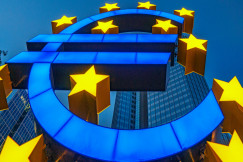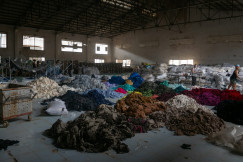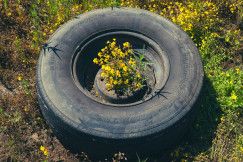Library
25 April 2025
Transition Pathway for a resilient, sustainable, and digital textiles ecosystem
Library
25 April 2025
Ecosystem's readiness to support EU strategic autonomy and defence efforts
Infrastructure
Investments and funding
+29 more
Login / create an account to be able to react

The EU’s Transition Pathway for the Textiles Ecosystem maps out how the industry can become more resilient, sustainable, and digital by 2030. It offers clear actions for businesses, public authorities, and stakeholders to work together in redesigning the future of textiles in Europe.
Topics
Albania
Armenia
Austria
Belgium
Bosnia and Herzegovina
Bulgaria
Croatia
Cyprus
Czechia
Denmark
Estonia
EU-27
Finland
France
Georgia
Germany
Greece
Hungary
Iceland
Ireland
Italy
Kosovo
Latvia
Liechtenstein
Lithuania
Luxembourg
Malta
Moldova
Montenegro
Netherlands
North Macedonia
Norway
Poland
Portugal
Romania
Serbia
Slovakia
Slovenia
Spain
Sweden
Switzerland
Türkiye
Ukraine
Academic / Research and VET Institutions
Business Support Organisation
Company with 250 or more employees
Cluster Organisations
Consumer Organisations
Cultural and Heritage Organisations
Destination Management & Marketing Organisations
EU Institutions
Financial Institutions and Investors
Industry Associations and Chambers of Commerce
International Organisations
Local Authorities
Media / Journalist Organisations
National authorities
Networks and Federations / Confederations
NGOs / Non-profits
Notified Bodies
Other
Regional Authorities
SMEs (a company with less than 250 employees)
Social Economy Entity
Trade Unions
-
Transition Pathway's building blocks
-
-
Ecosystem's readiness to support EU strategic autonomy and defence efforts
-
Infrastructure
-
Investments and funding
-
R&I, techniques and technological solutions
-
Skills
-
Social dimension
-
Sustainable competitiveness
-
Regulation and public governance
-
-
Industrial ecosystems
-
-
Aerospace and defence
-
Agri-food
-
Construction
-
Cultural and creative industries
-
Digital
-
Energy intensive industries
-
Energy-renewables
-
Health
-
Mobility, transport, automotive
-
Proximity and social economy
-
Retail
-
Textile
-
Tourism
-
-
Textiles ecosystem areas
-
-
Fibres, yarns and fabrics
-
Apparel and clothing accessories
-
Household/interior textiles
-
Technical textiles
-
Leather and fur
-
Footwear
-
Research and Innovation
-
Technology and Machinery
-
Waste management, reuse and repair
-
Business support and Communication
-
Not area specific (interested in more than one of the above)
-
Share
The European Commission released a staff working document that outlines possible scenarios and concrete actions for guiding the textile ecosystem through the green and digital transitions. This roadmap aims to co-create a more resilient, sustainable, and competitive sector by 2030, with a clear call for collaboration from industry, national authorities, and EU institutions.
The document highlights the pressing need to reconfigure the textiles value chain from manufacturing and sourcing to end-of-life processes. It reflects on the vulnerabilities exposed by the COVID-19 pandemic and the energy crisis and sets forward practical pathways to reduce dependency on global supply chains, foster circularity, and unlock digital innovation. For Small and Medium Enterprises (SMEs), which form the backbone of the EU textiles ecosystem, it presents opportunities to scale sustainable business models, modernise production, and access EU funding for innovation and upskilling.
Key Priorities and Scenarios
Resilience: Diversifying supply chains, building recycling capacity, investing in fibre-to-fibre technologies, and enabling SMEs to access EU funds are central to ensuring stability and competitiveness.
Sustainability: Actions include implementing eco-design principles, promoting reuse and repair models, increasing the use of recycled materials, and ensuring fair working conditions across global supply chains.
Digitalisation: The pathway supports greater uptake of digital tools and data sharing, with strong backing for digital innovation hubs, e-commerce support, and smart textiles research.
This document is a valuable reference for textiles manufacturers, designers, recyclers, innovators, and clusters looking to align with the EU’s sustainability vision. It offers practical tools to transition towards greener operations, access funding and skills development, and engage with upcoming policy reforms such as the Eco-design for Sustainable Products Regulation and the Digital Product Passport. Stakeholders are encouraged to help shape the future of the ecosystem by contributing to the co-creation process and making tangible pledges.
The pathway is not a prescriptive plan but an open framework for action. It presents a rare opportunity for the textile industry to actively lead on Europe’s green and digital future through innovation, collaboration, and commitment.
Read the full document here.
Documents
Comments (0)
See also
-
83
Small mid‑caps: bridging the gap between SMEs and large companies
- Categories
- Infrastructure Investments and funding R&I, techniques and technological solutions +28 more
-
130
The EU’s vision for sustainable fashion: transforming the textiles sector by 2030
- Categories
- Infrastructure Investments and funding R&I, techniques and technological solutions +28 more
-
37
Advancing Sustainability: The LIFE Programme
- Categories
- Infrastructure Investments and funding R&I, techniques and technological solutions +28 more




